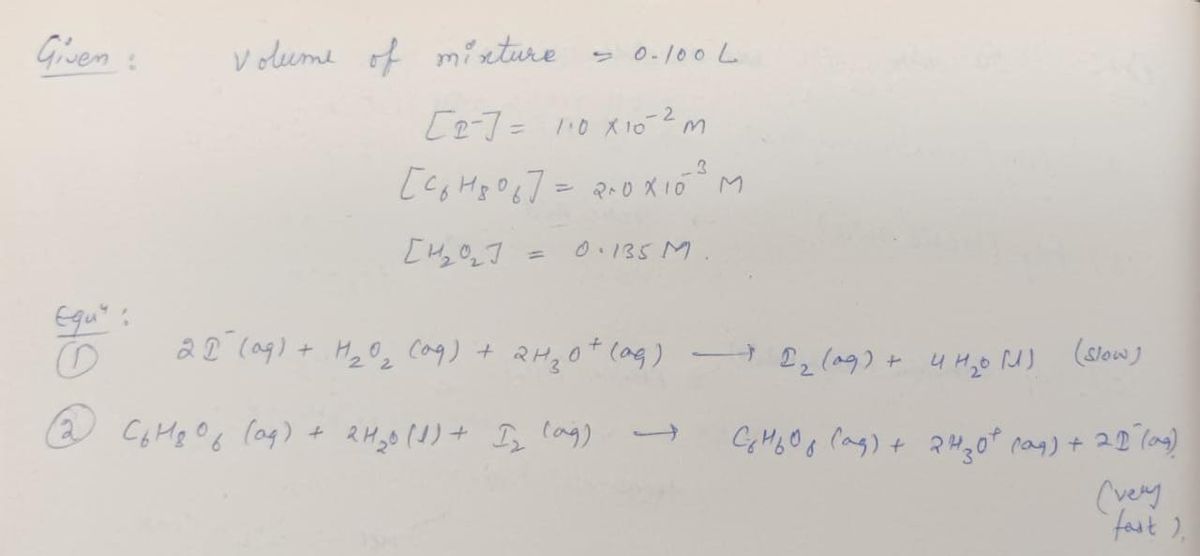2I– (aq) + H2O2 (aq) + 2H3O + (aq) → I2 (aq) + 4H2O (l) (slow) C6H8O6 (aq) + 2H2O (l) + I2 (aq) → C6H6O6 (aq) + 2H3O + (aq) + 2I– (aq) (very fast) I2 (aq) + I– (aq) ⇌ I – 3 (aq) I3- (aq) + starch → blue I3- · starch complex (aq) (fast) A different 0.100 L reaction mixture is prepared with initial concentrations of 1.0×10−2 M iodide I– , 2.0 × 10−3 M ascorbic acid C6H8O6 , and 0.135 M hydrogen peroxide H2O2 . If the first two reactions above procede at the same rate (they’re limited by the first one!), which of these reactants will be completely consumed first?
2I– (aq) + H2O2 (aq) + 2H3O + (aq) → I2 (aq) + 4H2O (l) (slow) C6H8O6 (aq) + 2H2O (l) + I2 (aq) → C6H6O6 (aq) + 2H3O + (aq) + 2I– (aq) (very fast) I2 (aq) + I– (aq) ⇌ I – 3 (aq) I3- (aq) + starch → blue I3- · starch complex (aq) (fast) A different 0.100 L reaction mixture is prepared with initial concentrations of 1.0×10−2 M iodide I– , 2.0 × 10−3 M ascorbic acid C6H8O6 , and 0.135 M hydrogen peroxide H2O2 . If the first two reactions above procede at the same rate (they’re limited by the first one!), which of these reactants will be completely consumed first?
Chemistry
10th Edition
ISBN:9781305957404
Author:Steven S. Zumdahl, Susan A. Zumdahl, Donald J. DeCoste
Publisher:Steven S. Zumdahl, Susan A. Zumdahl, Donald J. DeCoste
Chapter1: Chemical Foundations
Section: Chapter Questions
Problem 1RQ: Define and explain the differences between the following terms. a. law and theory b. theory and...
Related questions
Question
2I– (aq) + H2O2 (aq) + 2H3O + (aq) → I2 (aq) + 4H2O (l) (slow)
C6H8O6 (aq) + 2H2O (l) + I2 (aq) → C6H6O6 (aq) + 2H3O + (aq) + 2I– (aq) (very fast)
I2 (aq) + I– (aq) ⇌ I – 3 (aq)
I3- (aq) + starch → blue I3- · starch complex (aq) (fast)
A different 0.100 L reaction mixture is prepared with initial concentrations of 1.0×10−2 M iodide I– , 2.0 × 10−3 M ascorbic acid C6H8O6 , and 0.135 M hydrogen peroxide H2O2 . If the first two reactions above procede at the same rate (they’re limited by the first one!), which of these reactants will be completely consumed first?
Expert Solution
Step 1

Trending now
This is a popular solution!
Step by step
Solved in 2 steps with 2 images

Knowledge Booster
Learn more about
Need a deep-dive on the concept behind this application? Look no further. Learn more about this topic, chemistry and related others by exploring similar questions and additional content below.Recommended textbooks for you

Chemistry
Chemistry
ISBN:
9781305957404
Author:
Steven S. Zumdahl, Susan A. Zumdahl, Donald J. DeCoste
Publisher:
Cengage Learning

Chemistry
Chemistry
ISBN:
9781259911156
Author:
Raymond Chang Dr., Jason Overby Professor
Publisher:
McGraw-Hill Education

Principles of Instrumental Analysis
Chemistry
ISBN:
9781305577213
Author:
Douglas A. Skoog, F. James Holler, Stanley R. Crouch
Publisher:
Cengage Learning

Chemistry
Chemistry
ISBN:
9781305957404
Author:
Steven S. Zumdahl, Susan A. Zumdahl, Donald J. DeCoste
Publisher:
Cengage Learning

Chemistry
Chemistry
ISBN:
9781259911156
Author:
Raymond Chang Dr., Jason Overby Professor
Publisher:
McGraw-Hill Education

Principles of Instrumental Analysis
Chemistry
ISBN:
9781305577213
Author:
Douglas A. Skoog, F. James Holler, Stanley R. Crouch
Publisher:
Cengage Learning

Organic Chemistry
Chemistry
ISBN:
9780078021558
Author:
Janice Gorzynski Smith Dr.
Publisher:
McGraw-Hill Education

Chemistry: Principles and Reactions
Chemistry
ISBN:
9781305079373
Author:
William L. Masterton, Cecile N. Hurley
Publisher:
Cengage Learning

Elementary Principles of Chemical Processes, Bind…
Chemistry
ISBN:
9781118431221
Author:
Richard M. Felder, Ronald W. Rousseau, Lisa G. Bullard
Publisher:
WILEY